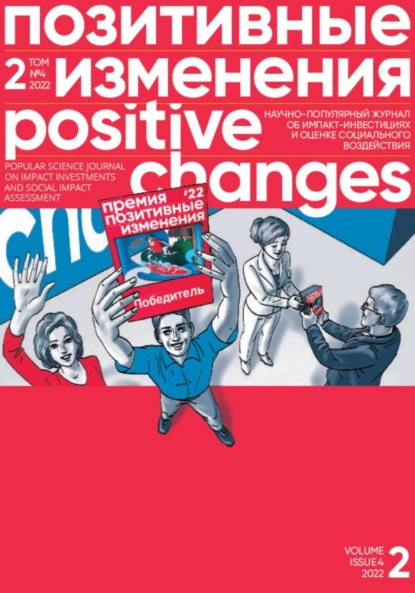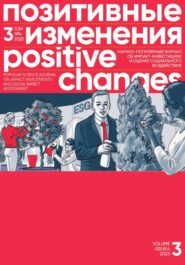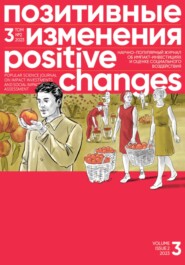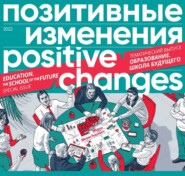По всем вопросам обращайтесь на: info@litportal.ru
(©) 2003-2024.
✖
Позитивные изменения. Том 2, №4 (2022). Positive changes. Volume 2, Issue 4 (2022)
Настройки чтения
Размер шрифта
Высота строк
Поля
Наследие движения Сэмаыль выходит далеко за границы обычного исторического явления и вдохновляет жителей сельских территорий в разных частях света.
ТРУДОЛЮБИЕ, САМОПОМОЩЬ И СОТРУДНИЧЕСТВО
К деятельности тренингового центра Сэмаыль Ундон были приглашены: члены органов государственной власти в качестве наставников; люди, которые делились своим опытом; представители интеллигенции и квалифицированные специалисты, которые обучали конкретным практическим навыкам. Возможность поступить в Центр Сэмаыль Ундон предоставлялась лидерам движения, выбранным деревней с помощью голосования. Таких представителей от каждой сельской территории было два человека: мужчина и женщина – они должны были вести за собой жителей сельской территории, вселять «Дух Сэмаыль» («Saemaul spirit»), который основывался, как уже отмечалось ранее, на трех компонентах: трудолюбие, самопомощь и сотрудничество. Кроме того, лидеры «движения за новую деревню» являлись связующим звеном в решении более серьёзных бюрократических вопросов с администрацией и организовывали различные собрания внутри деревни для решения насущных вопросов: распределения ресурсов, способов максимизации прибыли и улучшения инфраструктуры.
Одно из значимых изменений, достигнутых сельскими жителями благодаря Сэмаыль Ундон, можно увидеть в более прогрессивном отношении корейцев к жизни.
Что в итоге? Ключевым достижением Сэмаыль Ундон является стремительное снижение уровня бедности сельских территорий за счёт повышения доходов деревни в 8,7 раза в период с 1970 по 1979 год. Ярким показателем модернизации стал отчёт правительства о том, что заработок аграрных территорий заметно превышал урбанистический в 1974 году (Там же). В то время на городское население приходилось 52 % от общего количества жителей, проживающих на территории Южной Кореи, тогда как к концу программы это число возросло до 70 % с возможностью производства больше 80 % валового национального продукта (ВНП).
Эмпирические исследования по поводу результатов инициативы показывают влияние Сэмаыль Ундон на мировоззрение сельских жителей. В 1970 году 52 % опрошенного населения положительно относились к самопомощи и в принципе к самостоятельности, впоследствии этот показатель достиг 82 % в 1975 году. Степень готовности к сотрудничеству, измеренная в том же исследовании, выросла за пять лет с 47,4 % до 76,2 %. Напротив, склонность отказываться от self-help и кооперации снизилась с 8,2 % в 1970 году до 2,3 % в 1975 году (по данным Korean Saemaul Undong Center, 2018).
Одно из значимых изменений, достигнутых сельскими жителями благодаря Сэмаыль Ундон, можно увидеть в более прогрессивном отношении корейцев к жизни. Уже в начале программы, в 1970 м году, 48,9 % опрошенных ответили, что окружающие их люди, как и они сами, охотно принимают новый образ мышления, новые технологии и методы, а к 1975-му году этот показатель составил 80,5 % (Там же).
КАТАЛИЗАТОРЫ
Каждое действие должно быть чем-то мотивировано, должно быть что-то, что вело бы человека вперед: к достижению цели, к успеху. Что явилось таким катализатором для жителей южнокорейских деревень? Что вдохновило их изменить привычный уклад жизни?
Безусловно, большую роль сыграла политика соперничества, упомянутая ранее. Трансляция успешного опыта Сэмаыль Ундон во время тренинговых программ, которая поднимала и развивала «дух Сэмаыль», вселяла веру в лучшее. Кроме того, действия органов местного самоуправления и их отношения с деревней были модернизированы, привнося феномен более гибкой и адаптивной политики государства по отношению к жителям аграрных районов. Деревенские собрания и возможность инициативного бюджетирования не только предоставили жителям возможность самостоятельно распоряжаться ресурсами, научиться самим решать наиболее значимые вопросы, но и наглядно продемонстрировали необходимость этих элементов для успеха.
ЧТО ПРЕДСТАВЛЯЕТ СОБОЙ СЭМАЫЛЬ УНДОН В СОВРЕМЕННОМ МИРЕ?
С одной стороны, это теперь большое общенациональное движение, которое объединяет тысячи жителей страны, готовых прийти на помощь там, где она требуется – во время чрезвычайных ситуаций в стране и мире.
С другой стороны, Международный Центр Сэмаыль Ундон – организация, которая занимается внедрением программ развития сельских территорий в развивающихся странах. Центр представляет собой сетевую платформу, которая способствует обмену опытом, удачными кейсами, способствует укреплению сотрудничества между участниками проектов из разных стран, которые хотят перенять опыт Сэмаыль Ундон (Douglass, 2014). В 2016 году создана Saemaul Undong Global League для закрепления устойчивого развития, куда под эгидой Республики Корея входят ещё 46 стран[82 - Основные исторические этапы и события в развития движения Сэмаыль представлены на сайте Центра Сэмаыль: https://www-en.saemaul.or.kr/sub/aboutSMU/history.php.].
По состоянию на 2022 год программа проводится на территории 10 стран мира в 42 деревнях[83 - Карта территорий, участвующих в программе Сэмаыль, доступна на сайте Центра Сэмаыль: https://www-en.saemaul.or.kr/sub/globalSMU/overseas.php.]. В каждой стране она осуществляется в несколько этапов: сначала выбираются предполагаемые объекты реализации на конкурсной основе – территории, проявляющие наибольший интерес и показывающие свой потенциал и желание изменений. После отбора представителей от каждой сельской территории везут в Корею, где проводится тренинговая программа обучения для лидеров с вдохновляющим рассказом об истории, успехе Сэмаыль Ундон, с самими лидерами, которые делятся опытом и стараются наглядно показать, как дух самопомощи, самоподдержки и сотрудничества становится основополагающим элементом модернизации сельских регионов. Для каждой отдельной территории разрабатывается проект развития и бюджетирования, которым занимаются две стороны: корейский Центр Сэмаыль и правительственное учреждение по вопросам местного самоуправления страны, где будет осуществляться проект – на основе уже имеющихся показателей и возможности внедрения новых технологий. В течение всего времени реализации проекта Центр Сэмаыль занимается мониторингом результатов модернизации для выявления наиболее подходящих и эффективных методов для каждой отдельно взятой сельской территории. Однако главным элементом остаётся вовлечение самих жителей: лекционная часть, групповые обсуждения, поездки на территории – всё для того, чтобы создать прочный базис для успеха инициативы.
Можно говорить о том, что с одной стороны, современный вариант развития сельских территорий через движение Сэмаыль, основанный на ценностях трудолюбия, само – и взаимопомощи, является устойчивой и эффективной практикой, а с другой стороны, о возможности переноса «духа Сэмаыль» за пределы страны, о его потенциале вдохновлять людей на изменения через историю успеха, часто – даже очень далекой от них страны.
В заключение скажем, что в 2013 году ЮНЕСКО приняла архивы «Движения за новую деревню» к внесению в реестр «Память мира» как важный объект культурного наследия, способный дать надежду развивающимся странам[84 - The Archives of Saemaul Undong (New Community Movement). (2012). Retrieved from: https://ru.unesco.org/sites/default/files/korea_saemaul_undong.pdf. (accessed 12.12.2022).]. Между тем элементы Сэмаыль Ундон, механизмы его реализации и имеющийся опыт представляют интерес как для академических исследователей, так и практиков по всему миру – как уникальная практика, способная вдохновлять людей далеко за пределами эпохи ее создания, а также далеко за пределами страны, в которой она была изобретена.
ЛИТЕРАТУРА
1. Douglass, M. (2014). The Saemaul Undong in historical perspective and in the contemporary world. In Learning from the South Korean Developmental Success (pp. 136–171). Palgrave Macmillan, London.
2. Reed, E. P. (2010). Is Saemaul Undong a Model for Developing Countries Today? Anniversary of Saemaul Undong Hosted by the Korea Saemaul Undong Center.
3. Kim, D. K. (2012). The Saemaul Undong Movement in the Republic of Korea: Sharing Knowledge on Community-Driven Development. Mandaluyong City, Philippines: Asian Development Bank, 415–453.
4. Korean Saemaul Undong Center (2018). Saemaul Undong in Korea, p. 91.
The New Village Movement: South Korea's Experience in Rural Development[85 - This publication was supported by the 2020 Korean Studies Grant Program of the Academy of Korean Studies (AKS-2020-R-94).]
“Modernization of the village through the modernization of consciousness” was the call of Saemaul Undong, or the “new village movement.” A government program that began in the 1970s with actions that were, at first glance, very simple, has grown into a nationwide movement that still exists in the country today. “The Spirit of Saemaul,” according to experts, has become an inspirational story for many state campaigns in which the main element is the idea of residents coming together to create a common good and prosperity. It has also become an inspiration to the more than one hundred rural areas around the world that are introducing the “new village movement” based on the Saemaul International Center in our time.
Natalia Gladkikh
PhD in Psychology, Leading Expert, Centre for Technological Innovations, Institute of Social and Economic Design at the Higher School of Economics
Karina Chistiakova
HSE Lyceum
THE SOUTH KOREAN MIRACLE
The Saemaul movement, unlike other programs of Park Chung-hee, the president of the Republic of Korea under whom the country brought the legendary “Miracle on the Han River” to the world, is not as popular as a subject of research interest. However, just like the unprecedented growth of the country's economy (the average annual income of the population rose from $87 per person in 1962 to $4,830 in 1989[86 - EREPORT.RU. (2022). Economy of the Republic of Korea (Economy of South Korea). Retrieved from: http://www.ereport.ru/articles/weconomy/skorea.htm?ysclid=lcrvftprwf913528172. (accessed: 12.12.2022).]), the success of the “new village movement” is attributed by researchers both to the historical era, conditions of that time, cultural specifics of the country, and the personality of Park Chung-hee himself (Reed, 2010). All of these factors seem to suggest that such a transformation is unlikely to be of interest in today's world. Meanwhile, the legacy of the Saemaul movement goes far beyond the usual historical phenomenon. It is a program that has succeeded over the past several decades in inspiring people in rural areas around the world to repeat South Korea's “success story.”
The symbolism, like the name Saemaul Undong itself, is a reflection of the concept and key features of the initiative – each element of the name has multiple meanings. Literally, the program translates from Korean as “movement for a new village” (Saemaul Undong; ?????; ? – new, ?? – village, ?? – movement), but there is a deeper meaning: ? also means “blossom,” “modernization.” The three-petal sprout depicted on the initiative's flag symbolizes the three key components of the project: hard work, cooperation, and self-help, which are the foundation of the program, while the yellow circle represents the well-being that will result from its implementation. Green, the color of nature, signifies the ecological revolution that took place during Saemaul Undong (Kim, 2012).
HOW IT ALL BEGAN
To begin with, let us consider what the “New Village Movement” was like at its inception. It all started in 1971, when the state promoted the free distribution of 335 bags of cement to every village so that the locals would try to change the appearance of their areas with their own efforts. This strategy was later upgraded to a policy of “we help those who can help themselves”: a declaration of competition between villages for more funding from the state. Thus, if the village, using only the basic resources provided, is able to improve the standard of living on its own, to effectively carry out the modernization of its territories, it receives even greater support from the state. Accordingly, territories were divided into three classes: underdeveloped, developing, and developed.
However, it is precisely the financial support that is the least important element of Saemaul Undong, which would clearly be insufficient to get the results achieved. In 1972, the Saemaul Undong Training Center was established.
The legacy of the Saemaul movement goes far beyond the usual historical phenomenon and inspires people in rural areas around the world.
In the movement, an orientation towards “modernization of consciousness” through professional training appears, which was able to reform the attitude of the population from passive submission to self-confidence. In fact, the purpose of such training programs was, on the one hand, to educate, and on the other hand, to inspire change in rural areas. “Stereotypical thinking towards selfishness and carelessness has been reformed into altruism, responsibility, and public morality under the rule of law” (Ibid., p. 27). Samael Undong focused the attention of villagers on achieving a “better life” through the realization of their own potential. The program has made people more confident in using resources to maximize productivity, and the “can-do” aspect has shown that residents can guarantee their own existence in better conditions.
HARD WORK, SELF-HELP AND COOPERATION
The following were invited to participated in the activities of the Saemaul Undong Training Center: members of state authorities as mentors, people who shared their experiences, intellectuals, and qualified professionals who taught specific practical skills. The opportunity to join the Saemaul Undong Center was given to movement leaders chosen by the village through voting. There were two such representatives from each rural territory: a man and a woman who were to lead the villagers and instill the “Saemaul spirit,” which was based, as noted earlier, on three components: hard work, self-help, and cooperation. In addition, the leaders of the New Village Movement were the liaisons for the more serious, bureaucratic issues with the administration and organized various meetings within the village to address pressing issues: resource allocation, ways to maximize profits, and infrastructure improvements.
What is the bottom line? The key achievements of Saemaul Undong are the rapid reduction in rural poverty through an 8.7-fold increase in village income between 1970 and 1979. A striking indicator of modernization was the government's report that agrarian earnings were markedly higher than urban earnings in 1974 (Ibid.). At that time, the urban population accounted for 52 percent of the total population living in South Korea, whereas by the end of the program that number had risen to 70 percent with the ability to produce more than 80 percent of the gross national product (GNP).
One of the significant changes achieved by the villagers thanks to Saemaul Undong can be seen in Koreans' more progressive attitude towards life.
Empirical research of the results of the initiative shows the impact of Saemaul Undong on the worldview of villagers. In 1970, 52 % of the surveyed population had a positive attitude towards self-help and self-sufficiency in principle; subsequently, this figure reached 82 % in 1975. The degree of willingness to cooperate, measured in the same study, increased over five years from 47.4 % to 76.2 %. In contrast, the propensity to refuse self-help and cooperation decreased from 8.2 % in 1970 to 2.3 % in 1975 (according to Korean Saemaul Undong Center, 2018).
One of the significant changes achieved by the villagers thanks to Saemaul Undong can be seen in Koreans' more progressive attitude towards life. As early as at the inception of the program, in 1970, 48.9 % of those surveyed responded that the people around them, like themselves, were willing to accept the new way of thinking, new technologies and methods, and by 1975 the figure was 80.5 % (Ibid.).
CATALYSTS
Every action must be motivated by something, there must be something that would lead a person forward: to the goal, to success. What was such a catalyst for South Korean villagers? What inspired them to change their way of life?
Of course, the rivalry policy mentioned earlier played a big role. Broadcasting the successful experience of Saemaul Undong during the training programs, which raised and developed the “spirit of Saemaul,” instilled faith in the best. In addition, the actions of local governments and their relations with the village have been modernized, bringing the phenomenon of a more flexible and adaptive state policy towards the inhabitants of agrarian areas. Village meetings and the opportunity for proactive budgeting not only gave residents the opportunity to manage resources on their own and learn to solve the most important issues themselves, but also clearly demonstrated the need for these elements to achieve success.
WHAT DOES SAEMAUL UNDONG REPRESENT IN TODAY'S WORLD?
On the one hand, it is now a large nationwide movement that unites thousands of residents of the country who are ready to come to the aid where it is needed – during emergencies in the country and the world.
On the other hand, the International Saemaul Undong Center is an organization that implements rural development programs in developing countries. The Center is a networking platform that facilitates the exchange of experiences, successful cases, and fosters collaboration among project participants from different countries who want to learn from Samael Undong's experience (Douglass, 2014). In 2016, the Saemaul Undong Global League was established to consolidate sustainable development, which includes 46 other countries under the auspices of the Republic of Korea[87 - The main historical stages and events in the development of the Saemaul movement are presented on the website of the Saemaul Center: https://www-en.saemaul.or.kr/sub/aboutSMU/history.php.].
As of 2022, the program is being conducted in 10 countries in 42 villages[88 - A map of the areas participating in the Saemaul program is available on the website of the Saemaul Center: https://www-en.saemaul.or.kr/ sub/globalSMU/overseas.php.]. In each country, it is carried out in several stages: first, the intended objects of implementation are selected on a competitive basis – the territories that show the greatest interest and demonstrate their potential and desire for change. After selection, representatives from each rural area are taken to Korea, where a leadership training program is held with an inspiring story of the success of Saemaul Undong, with the leaders themselves sharing their experiences and trying to demonstrate how the spirit of self-help, self-support and cooperation is becoming a fundamental element of rural modernization. For each individual territory, a development and budgeting project is designed by two parties: the Korean Saemaul Center and the local governmental agency of the country where the project will be implemented – based on the existing indicators and the possibility of introducing new technologies. Throughout the duration of the project, the Saemaul Center monitors the results of modernization to identify the most appropriate and effective methods for each individual rural area. However, the involvement of the residents themselves remains the main element: lectures, group discussions, site visits – all to create a solid basis for the success of the initiative.
We can talk about how, on the one hand, the modern version of rural development through the Saemaul movement, based on the values of hard work, self- and mutual assistance, is a sustainable and effective practice, and on the other hand, about the possibility of transferring the “spirit of Saemaul” outside the country, about its potential to inspire people to change through a success story, often even a very distant country from them.
In conclusion, in 2013 UNESCO accepted the archives of the New Village Movement for inclusion in the Memory of the World Register as an important cultural heritage that could provide hope for developing countries[89 - The Archives of Saemaul Undong (New Community Movement). (2012). Retrieved from: https://ru.unesco.org/sites/default/files/korea_saemaul_undong.pdf. (accessed 12.12.2022).]. Meanwhile, the elements of Saemaul Undong, the mechanisms for its implementation, and the experiences available are of interest to both academic researchers and practitioners around the world as a unique practice capable of inspiring people far beyond the era of its creation, and far beyond the country in which it was invented.














